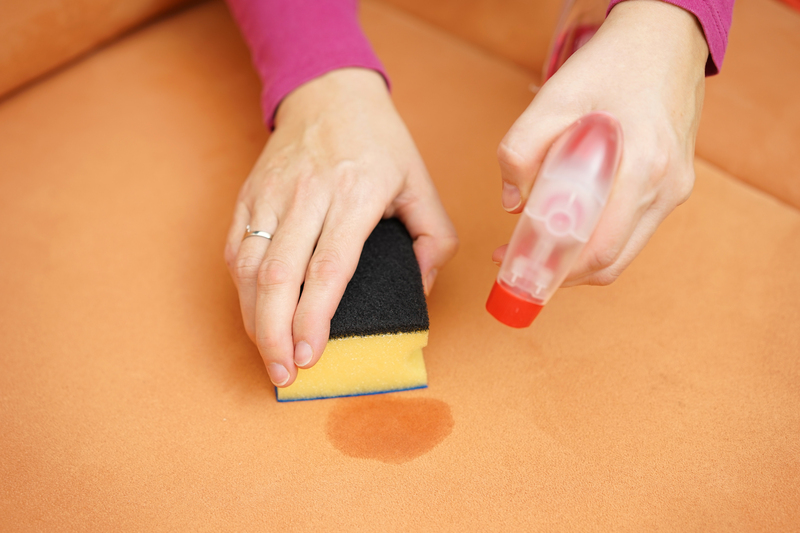Boost Employee Morale with Superior Air Quality
Posted on 05/10/2025
Boost Employee Morale with Superior Air Quality
In today's fast-paced business world, organizations are constantly searching for new strategies to motivate employees and improve productivity. One game-changing approach is often overlooked: enhancing workplace air quality. Superior indoor air quality doesn't just safeguard health -- it also plays a vital role in uplifting employees' moods, improving focus, and creating a more positive company culture. In this comprehensive article, we'll explore how improving office air quality can boost employee morale, and reveal actionable steps for transforming your work environment.

Understanding the Connection between Air Quality and Employee Morale
Air is the one thing we all share in the workspace. While employees may not notice invisible pollutants, indoor air quality directly impacts physical well-being, energy levels, and even mental health. Poor air can induce symptoms such as headaches, fatigue, eye irritation, and even long-term respiratory problems. Over time, these effects sap morale, diminish engagement, and undermine team collaboration.
The Science behind Air Quality and Morale
- Cognitive Performance: Studies show that clean air directly enhances cognitive function -- employees process information faster, concentrate better, and make sharper decisions.
- Physical Comfort: Fresh, filtered air reduces allergens and pollutants, which means fewer staff complaints and sick days.
- Mental Health: Good air quality decreases stress and anxiety, cultivating a more energized, positive workplace atmosphere.
By investing in superior air quality, employers show they genuinely care about the well-being of their teams. This not only helps with talent retention but also encourages higher levels of employee satisfaction and loyalty.
Why Superior Air Quality Is Essential in the Workplace
Invisible Threats in Poor Air
Offices can become breeding grounds for airborne contaminants such as dust, mold spores, VOCs (volatile organic compounds), bacteria, and viruses. These pollutants accumulate from printers, cleaning supplies, office furnishings, and even poor ventilation. Exposure to these can trigger or worsen health problems, silently sabotaging morale and productivity.
The Many Benefits of Premium Air Quality at Work
- Greater Job Satisfaction: Employees who work in fresh, clean environments feel appreciated and valued, leading to heightened job happiness.
- Reduced Absenteeism: Cleaner air means fewer respiratory issues and less contagious illness, lowering sick leave rates and operational disruptions.
- Better Teamwork: When staff feel physically well, energy is channeled into communication and collaboration, not battling headaches or fatigue.
- Enhanced Focus and Productivity: Improved oxygen levels and reduced pollutants mean tasks are completed faster and with greater accuracy.
The Link between Indoor Air Quality and Company Culture
A healthy atmosphere drives a healthy culture. When leaders address environmental quality, they send a clear message: employee health matters. This fosters trust, encourages high performance, and creates a resilient, enthusiastic workforce ready to meet business challenges.
Actionable Strategies to Achieve Superior Air Quality in the Office
1. Invest in High-Performance Air Purifiers
Modern technology offers advanced air purifiers equipped with HEPA and carbon filters capable of capturing even the smallest airborne threats. Positioning these strategically -- especially in crowded office spaces, meeting rooms, and areas with limited natural airflow -- substantially reduces allergen and toxic particle levels.
2. Upgrade and Maintain HVAC Systems
A well-maintained HVAC system is the backbone of excellent office air quality. Schedule regular filter replacements and inspections. Seek energy-efficient models that include advanced filtration and humidity controls to keep the climate comfortable year-round.
3. Introduce Biophilic Design and Office Plants
Green is not just for aesthetics. Incorporating plants such as peace lilies, snake plants, and spider plants helps absorb toxins and release life-giving oxygen. These living air purifiers also bring calming, natural beauty to sterile office environments, positively affecting morale.
4. Prioritize Natural Ventilation
Whenever weather and security permit, open windows and doors. Natural airflow dilutes and removes indoor pollutants, replenishing the environment with fresh air. Design workspaces to encourage cross-ventilation and ensure perimeters are free from outdoor pollution sources.
5. Implement Non-Toxic Cleaning Practices
Switch to eco-friendly, low-VOC cleaning agents. Reduce reliance on harsh chemicals that contribute to poor indoor air quality. Train janitorial teams on proper ventilation during and after cleaning, and schedule major cleanings when fewest staff are present.
6. Minimize Office Pollutant Sources
- Adopt low-emission office furniture and building materials.
- Restrict smoking to well-ventilated, outdoor areas far from doors and windows.
- Regularly inspect for water leaks or mold growth which can silently deteriorate air quality.
7. Engage Employees in Air Quality Initiatives
Encourage transparency and education regarding the significance of air quality. Invite employee feedback on comfort and well-being. Post air quality metrics in common areas and offer "wellness days" to reinforce your commitment.
How to Measure and Monitor Office Air Quality
You can't improve what you can't measure. Continuous monitoring is key to retaining superior air quality in any workspace. Invest in smart sensors that measure:
- Particulate matter (dust, pollen, smoke)
- CO2 levels
- VOC levels
- Temperature and humidity
Monitor trends and act proactively. High CO2 can cause drowsiness; low humidity can irritate airways, while excess humidity allows mold to flourish. Display up-to-date statistics, so employees know their health is always top of mind.
Case Studies: Businesses That Have Elevated Morale with Air Quality
Innovative Tech Company Revitalizes Team Spirit
When a forward-thinking tech firm installed state-of-the-art HEPA filtration and real-time air quality monitors, employees reported 35% fewer headaches and fatigue. Team engagement scores soared, and voluntary overtime increased by 20% -- a testament to morale's turnaround.
Co-Working Space Attracts New Clients
A bustling co-working provider upgraded its HVAC to a hospital-grade system and introduced green walls in communal areas. Not only did existing members stay longer, but new client inquiries doubled thanks to positive word-of-mouth about the "energizing, fresh atmosphere."

Frequently Asked Questions About Air Quality and Employee Happiness
How quickly can improved air quality affect morale?
Many organizations observe an uptick in mood and energy within weeks of implementing comprehensive air quality programs. Symptoms such as fatigue and headaches often recede rapidly.
Are there inexpensive steps to boost indoor air quality?
Yes! Regularly airing out the office, adding more indoor plants, and switching to greener cleaning supplies offer cost-effective methods to significantly uplift air quality and workforce spirit.
Is superior air quality only important in large offices?
Absolutely not. Whether you operate a small boutique or manage a corporate skyscraper, every workplace benefits from cleaner air. Small spaces, in fact, may see more rapid transformation as pollutants disperse quickly with improved ventilation.
The True ROI: Productivity, Loyalty, and Growth
Improving office air quality generates measurable returns: fewer sick days, sharper focus, higher engagement, greater retention, and an improved public image. Companies that elevate air standards position themselves as truly modern, employee-focused organizations.
In summary, to boost employee morale with superior air quality:
- Invest in quality air purification and HVAC upgrades.
- Incorporate biophilic design and allow natural ventilation.
- Reduce indoor pollutants and measure results.
- Engage and empower employees in ongoing wellness programs.
Let's recognize that air -- the most basic of elements -- can transform any workplace. Make superior indoor air quality your next strategy for sparking team spirit, bolstering productivity, and future-proofing your business.
Take the First Step Toward a More Positive, Healthier Office
Are you ready to boost your team's morale, creativity, and overall well-being? Start by assessing your current air quality and embark on targeted improvements. Your employees will feel the difference -- and your organization will breathe easier, every day.
```



